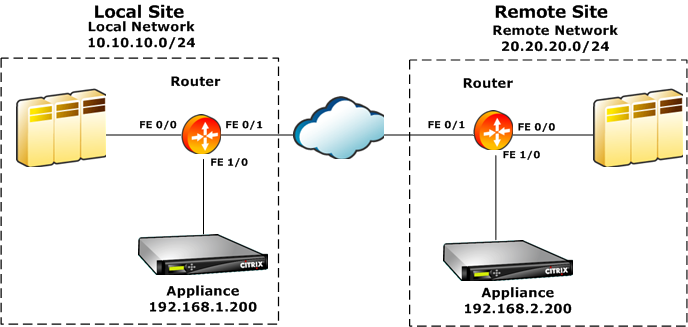Virtual Inline Mode
Note: Use virtual inline mode only when both inline mode and WCCP mode are impractical. Do not mix inline and virtual inline modes within the same appliance. However, you can mix virtual inline and WCCP modes within the same appliance. Citrix does not recommend virtual inline mode with routers that do not support health monitoring.
In virtual inline mode, the router uses policy based routing (PBR) rules to redirect incoming and outgoing WAN traffic to the appliance for acceleration, and the appliance forwards the processed packets back to the router. Almost all of the configuration tasks are performed on the router. The only thing to be configured on the appliance is the forwarding method, and the default method is recommended.
Like WCCP, Virtual inline deployment requires no rewiring and no downtime, and it provides a solution for asymmetric routing issues faced in a deployment with two or more WAN links. Unlike WCCP, it contains no built-in status monitoring or health checking, making troubleshooting difficult. WCCP is thus the recommended mode, and virtual inline is recommended only when inline and WCCP modes are both impractical.
Example
The following figure shows a simple network in which all traffic destined for or received from the remote site is redirected to the appliance. In this example, both the local site and remote site use virtual inline mode.
Figure 1. Virtual Inline Example

Following are some configuration details for the network in this example:
- Endpoint systems have their gateways set to the local router (which is not unique to virtual inline mode).
- Each router is configured to redirect both incoming and outgoing WAN traffic to the local appliance.
- Each appliance processes the traffic received from its local router and forwards it back to the router.
- PBR rules configured on the router prevent routing loops by allowing packets to make only one trip to and from the appliance. The packets that the appliance forwards back to the router are sent to their original (local or remote) destination.
- Each appliance has its default gateway set to the address of the local router, as usual (on the Configuration: Network Adapters page). The options for forwarding packets back to the router are Return to Ethernet Sender and Send to Gateway.
The official version of this content is in English. Some of the Cloud Software Group documentation content is machine translated for your convenience only. Cloud Software Group has no control over machine-translated content, which may contain errors, inaccuracies or unsuitable language. No warranty of any kind, either expressed or implied, is made as to the accuracy, reliability, suitability, or correctness of any translations made from the English original into any other language, or that your Cloud Software Group product or service conforms to any machine translated content, and any warranty provided under the applicable end user license agreement or terms of service, or any other agreement with Cloud Software Group, that the product or service conforms with any documentation shall not apply to the extent that such documentation has been machine translated. Cloud Software Group will not be held responsible for any damage or issues that may arise from using machine-translated content.
DIESER DIENST KANN ÜBERSETZUNGEN ENTHALTEN, DIE VON GOOGLE BEREITGESTELLT WERDEN. GOOGLE LEHNT JEDE AUSDRÜCKLICHE ODER STILLSCHWEIGENDE GEWÄHRLEISTUNG IN BEZUG AUF DIE ÜBERSETZUNGEN AB, EINSCHLIESSLICH JEGLICHER GEWÄHRLEISTUNG DER GENAUIGKEIT, ZUVERLÄSSIGKEIT UND JEGLICHER STILLSCHWEIGENDEN GEWÄHRLEISTUNG DER MARKTGÄNGIGKEIT, DER EIGNUNG FÜR EINEN BESTIMMTEN ZWECK UND DER NICHTVERLETZUNG VON RECHTEN DRITTER.
CE SERVICE PEUT CONTENIR DES TRADUCTIONS FOURNIES PAR GOOGLE. GOOGLE EXCLUT TOUTE GARANTIE RELATIVE AUX TRADUCTIONS, EXPRESSE OU IMPLICITE, Y COMPRIS TOUTE GARANTIE D'EXACTITUDE, DE FIABILITÉ ET TOUTE GARANTIE IMPLICITE DE QUALITÉ MARCHANDE, D'ADÉQUATION À UN USAGE PARTICULIER ET D'ABSENCE DE CONTREFAÇON.
ESTE SERVICIO PUEDE CONTENER TRADUCCIONES CON TECNOLOGÍA DE GOOGLE. GOOGLE RENUNCIA A TODAS LAS GARANTÍAS RELACIONADAS CON LAS TRADUCCIONES, TANTO IMPLÍCITAS COMO EXPLÍCITAS, INCLUIDAS LAS GARANTÍAS DE EXACTITUD, FIABILIDAD Y OTRAS GARANTÍAS IMPLÍCITAS DE COMERCIABILIDAD, IDONEIDAD PARA UN FIN EN PARTICULAR Y AUSENCIA DE INFRACCIÓN DE DERECHOS.
本服务可能包含由 Google 提供技术支持的翻译。Google 对这些翻译内容不做任何明示或暗示的保证,包括对准确性、可靠性的任何保证以及对适销性、特定用途的适用性和非侵权性的任何暗示保证。
このサービスには、Google が提供する翻訳が含まれている可能性があります。Google は翻訳について、明示的か黙示的かを問わず、精度と信頼性に関するあらゆる保証、および商品性、特定目的への適合性、第三者の権利を侵害しないことに関するあらゆる黙示的保証を含め、一切保証しません。
ESTE SERVIÇO PODE CONTER TRADUÇÕES FORNECIDAS PELO GOOGLE. O GOOGLE SE EXIME DE TODAS AS GARANTIAS RELACIONADAS COM AS TRADUÇÕES, EXPRESSAS OU IMPLÍCITAS, INCLUINDO QUALQUER GARANTIA DE PRECISÃO, CONFIABILIDADE E QUALQUER GARANTIA IMPLÍCITA DE COMERCIALIZAÇÃO, ADEQUAÇÃO A UM PROPÓSITO ESPECÍFICO E NÃO INFRAÇÃO.
